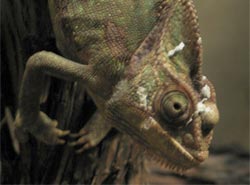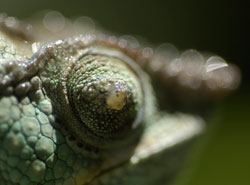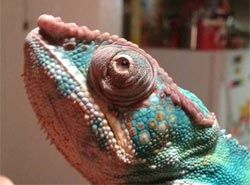Follow along with the video below to see how to install our site as a web app on your home screen.
Note: This feature may not be available in some browsers.
You should upgrade or use an alternative browser.
Head & Neck

Edema is an abnormal build-up of fluid under the skin. Chameleons are occasionaly diagnosed with gular edema, which can consist of swelling around the neck, throat and the area below their front legs. It is not specifically known why this build-up occurs but it is speculated to be a symptom of mineral imbalance (possibly calcium) or an indication of liver or kidney disease. The best treatment in the experience of some is as much natural sunlight as possible, significantly increased hydration and ensuring adequate calcium supplementation with very limited phosphorus content in food to promote good kidney health. Sometimes the edema goes away with time, and sometimes it is permanent, but may fluctuate. Occasionally edema is seen with gravid females and it resolves once the eggs are laid.

The sinuses of chameleons are located on the top part of the skull between the eyes and nostrils. You can see bumps appear over them when there is an infection of the sinuses because of swelling and pus formation, possibly secondary to an upper respiratory infection. Pus in reptiles is very thick and not liquid like in mammals, so while antibiotics are usually started for the infection that caused it, they won't get rid of the pus in the sinuses causing the swelling. Usually the sinus needs to be opened with minor surgery by a veterinarian to remove the pus from the infection.

Stomatitis or Mouth Rot is a symptom of systemic infection in chameleons. It has a wide variety of symptoms but it most notably displays as cheesy yellow pus in the soft tissues of the mouth. Other symptoms include swelling of the jaw or lip or blackened teeth. If left untreated the condition progresses to bacterial infections of the jawbone and other cranial structures which weakens the bones causing fractures and teeth may become loose. Systemic infection followed by death can occur. Mouth Rot requires veterinary treatment with appropriate antibiotics and cleaning out the pus and infected tissue in the jaw.

Sleeping during the day is often an indication of an underlying illness or disease, but having just one eye closed usually means there is a problem with the eye itself. It may be as simple as some debris (dust, dirt, etc) in the eye causing irritation and inflammation, or injury or infection. Additional misting sessions and flushing of the eye with saline will help flush out debris if present. If there is crusting or discharge from the eye that is an indication of infection.
A chameleon that is sitting with its mouth open could mean a few things. Since chameleons cannot sweat or pant the only way to try to get rid of extra body heat is evaporation through the moist tissues of the mouth. This could be an indication that the temperatures of its cage are too high and it can't thermoregulate appropriately. Alternatively, prolonged open mouth breathing could be an indication of a respiratory problem - see respiratory infection symptoms below.
Chameleons have a gland inside their nose to help get rid of excess salts from their diet. Since this gland is just inside the nostril they sneeze forcefully to expel the excess salt secretions so they don’t build up. This can cause a crusty white build-up around the nose. This is generally not a sign of illness if it is the only symptom. Crusts will fall off or can be wiped off with a moist Q-Tip if you desire.

Sunken eyes is a reference to when a chameleon's eyes appear sunken into their sockets. It is generally a sign of dehydration although it can also be a symptom of other underlying health issues or pain. This is a warning sign that chameleon owners must not ignore. Increasing misting times and offering better access to drippers and showers should help improve hydration. Chronic dehydration can lead to serious health problems.

Puffy swollen eyes, or blobs just under the eyes, most commonly indicate a blocked nasolacrimal duct, a local infection or a sinus infection. If the nasolacrimal duct is blocked it can cause debris to build up behind it and the duct may need to be flushed. If an infection is present then antibiotics may be required. Pus from infections in reptiles is very thick and not liquid like in mammals, so while antibiotics are usually started to battle these infections the pus from them will often remain. Sometimes the sinus or eye socket needs to be opened with minor surgery by a veterinarian to remove the pus from the infection.
Periodically a chameleon will bulge their eye(s) in and out of the socket. This is a normal cleaning behavior where the chameleon is attempting to dislodge possible foreign bodies under the eye. This is usually a quick process and nothing to be worried about unless the eye remains bulged.
A chameleon with bad aim, a non-sticky tongue, or a tongue that seems too short is a serious problem because it can prevent them from eating. A number of problems can cause tongue troubles including, but not limited to, an injury to the tongue, calcium deficiency, vitamin or mineral imbalance, a problem in the mouth (abscess, etc), dehydration, and sight problems. The tongue hanging out of the mouth where the chameleon cannot pull it back in is a medical emergency. Keep the tongue moist until it can be seen by a reptile vet. If the tongue cannot be saved by prompt medical attention it may need to be amputated. Chameleons can usually adapt to eating without a tongue in time.

With chameleons an upper respiratory infection is caused by a bacterial infection on the lungs. URI’s are generally related to improper environmental conditions such as being kept too cold or too wet. Symptoms include difficulty breathing, gaping, excessive mucous in the mouth, discharge from the mouth or nose, popping or wheezing sounds, decreased appetite and reduced activity. An upper respiratory infection requires immediate treatment by a reptile veterinarian as antibiotics to treat the infection are needed. An immediate evaluation of temperatures, humidity and ventilation will assist in healing. If left untreated infection can turn into pneumonia which is more severe and harder to treat prolonging recovery.
This is an unusual symptom in chameleons and reptiles in general. Poor digestion could be caused by inadequate basking temperatures, dehydration, intestinal parasites or bacterial overgrowth. Make sure prey items are the correct size (no longer than the space between your chameleon's eyes) and that basking temperatures are appropriate to encourage good digestion. If the vomiting continues despite this, submit a fecal sample to your reptile vet for testing. Other diagnostics like blood work or x-rays may be needed.
